
LEXUS LS
Generations Timeline, Specs and Pictures
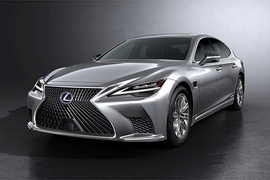
Lexus introduced the fifth generation of the LS in 2017 and updated it in 2020, after three decades on the market.
It was the real Japanese alternative for the luxury German brands.
By 2020, most car-customers within the premium segment knew that Lexus was founded as the Toyota’s premium brand. Lexus made a name of itself by topping the reliability charts all over the world, and offering hybrid versions long before they were a cool thing. The 2020 LS was updated with new features and technologies.
From the outside, there were minor modifications to the bodywork. At the front, the car featured a redesigned air-scoops in front of the wheels, with a mesh-grille instead of horizontal slats. At the bottom, the car-maker installed the radar for the adaptive cruise control system on the main grille. The air-vent behind the front wheel-arches was new as well. In the back, the designers applied a new design for the apron.
Inside, the 2020 model featured a wrap-around sensation of the dashboard, which was continued on the door panels with the same materials and textures. The screen for the infotainment system was fitted with a 12.3” screen. It wasn’t a touch-screen, but it was Apple CarPlay and Android Auto compatible. To access its menus, Lexus installed a touch-pad on the center console.
For the drivetrain, the car-maker installed the same powertrain as before: a twin-turbo 3.5-liter V6 plus an electric motor. It offered the LS500 with either a rear or an all-wheel-drive system.
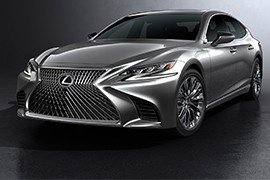
In 2017, the Lexus LS got renewed getting in line with the automaker’s latest design language and technology.
Visually, the luxury sedan adopted the sharp flowing lines of the other models in the range along with all LED lights, new rims, colors, and the instantly recognizable spindle grille garnished with chrome and an intricate mesh. The interior is also new while coming with even better sound proofing and the latest technology. Technically, the car is longer, wider, and lower, now sharing the same platform with the LC coupe (GA-L). The big naturally aspirated V8 has been ditched and replaced with a turbocharged V6 for the 500 flavor.
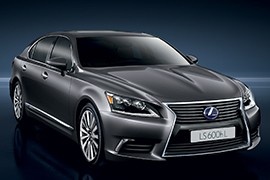
Lexus introduced the second and final facelift for the fourth generation of its flagship model, the LS series.
Toyota might have run out of money since it didn’t introduce a new generation for the LS, or it tried just to postpone the fifth generation for later, to get more media coverage yearly. In 2011 Lexus launched the fourth generation of the GS and unveiled a near-production concept for the IS in late 2012. But the LS had to wait until 2017 to be completely renewed.
The design team applied the new spindle-face image on the big barge as on its smaller siblings. Even though it was still controversial, it was already a brand image, and Lexus tried to make a bold statement. The carmaker made an LED light package available that included headlights, turn signals, and fog-lights. For the first time, the LS became available with an F-Sport package, with the exclusive white-color on it.
Inside, Toyota heavily improved the LS. Its design concept revealed two distinct areas: the driver’s, and the rest of the car. Lexus installed a 5.8” TFT display in the instrument cluster for the on-board computer. A new, 12.3” screen found its place on top of the center console. The carmaker considered introducing heated steering wheels on all AWD models and added a quick warm-up system for the front passengers.
For the technical department, Lexus didn’t consider that there were any necessary upgrades. It offered the same 4.6-liter V8 for the entire lineup, provided with a choice of two power outputs. The hybrid version kept the same 4.9-liter V8 as the non-facelifted model.

The Lexus LS lineup included the LS 460, the LS 460 L (the long-wheelbase version) and the LS 600h hybrid.
The LS was one of the quietest and smoothest luxury sedans at that time. The LS 460 was driven by a 4.6-liter V8 engine that was mated with an 8-speed automatic transmission. As a nice feature to add to the luxury offered, the steering system was adjusting with the vehicle’s speed.
The LS 600h was equipped with a hybrid powertrain and featured a 5.0-liter V8, and together with the electric motors, it was rated at a total of 438 hp. The LS 600h was certified as a SULEV (super ultra-low emission vehicle) and was only available with the long wheelbase.
New for 2009, both sedans could be equipped with an all-wheel-drive system.
The base models were incredibly well equipped, as well as an extensive list of optional features was available.
The safety equipment included 8 airbags, ABS, electronic brake assist, ESP, adaptive headlights and tire-pressure monitoring. A smart system was added to the list of safety features: a pre-collision system that was designed to move the seats to a neutral position and automatically closed the windows and the sunroof, and tightened the belts to reduce the risk of serious injuries.
The LS lineup offered a great combination of comfort, space and luxury.

Since its establishment as the luxury division of Toyota in the 1980s, Lexus has slowly grown into a serious contender in its segment.
Presently, the family of Lexus cars includes everything from sedans to SUVs.
One of the earlier models in the Lexus lineup is the LS. Introduced by the Japanese in 1989 as V8-powered, rear-wheel-drive luxury on wheels, the LS has been in production ever since, and it is now in its fifth generation.
The 2006 model year we have here is part of the fourth generation, and was an instant hit right from the start, earning in the home market the Car of the Year award.
Offered with a choice of two gasoline (on the 460 variant) and two hybrid engines (on the 600h), the LS from 2006 was the first to use what the Japanese called at the time “the world’s first eight-speed automatic transmission.”
Having had enough experience with the Prius and having just launched the first Lexus hybrid, the RX 400h one year earlier, the Japanese also fitted the LS with a hybrid powertrain, making the LS 600h the world’s first gasoline-electric hybrid luxury car.
The 2006 version of the LS was kept in production for three years when it was replaced by a mildly modified version.

Lexus put the best technologies in the third generation of the LS in 2000, and then it made it even better in 2003.
The third generation of the Lexus LS was the first vehicle to receive a five-star anti-theft rating globally, leaving the car-thieves behind with its technology. The Japanese carmaker wanted to ensure its customers that they will have the vehicle as long as they wish. Moreover, it tried to protect them as well as they could by installing advanced safety systems.
Lexus slightly redesigned the exterior for the refreshed model and introduced slimmer fog lights and a different bumper. Its headlights received a significant upgrade with the HID (Bi-Xenon), while the taillights received a full-LED system. But its overall lines were similar to the Mercedes-Benz E-Class, and that spoiled the brand’s originality.
Inside, the walnut wood-trims on the dash, doors, and center console from the non-facelifted version were kept—the facelifted version carried over the DVD-based navigation system and Lexus Telematic infotainment unit. An important step forward in the safety department was the introduction of the knee airbag to complement the dual front and side curtain airbags.
Under the hood, there was no surprise to find the same 4.3-liter V8 that provided 282 hp. The engine sent its power to the rear wheels via a 6-speed automatic transmission.

The third generation LS grew even bigger than its predecessors, but it failed to bring the same note of innovation, becoming more of a revision of past models.
Due to restyling the car was even more aerodynamic and because the engine was moved further rearward it achieved better stability. Again options were at a premium, with a top notch sound system and dynamic cruise control. However, this time around, the prices fell to impress customers. This doesn’t mean that the third generation wasn’t a best seller, because in its first year, it became the number one selling vehicle in the US.
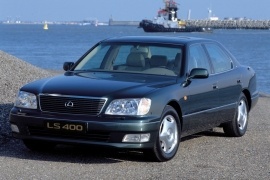
After just three years since it launched the second generation, Lexus refreshed its flagship model, the LS.
When the Japanese carmaker started introducing the Lexus as a premium brand on the U.S. market, it brought different vehicles than the standard U.S. specifications Toyota. The LS, for instance, was the Japanese Toyota Celsior, which was not available anywhere else. For its flagship model, Toyota offered just the best technologies it had, and that’s one reason why it refreshed the lineup after only three years.
For the 1997 model, Lexus improved its quality control and soundproofings. On the exterior, the carmaker redesigned the front fascia that sported a new grille. The door-mirrors were changed as well to diminish the wind noise. Last but not least, the carmaker deleted the regular power-antenna, with a rear-window incorporated one.
Inside, the car received an on-board computer that showed the fuel consumption, estimated range, and daily trip meters. A new climate control system with an improved filter found its way under the dashboard. The center stack featured an optional CD-based navigation system. It wasn’t very advanced, but it could show directions better than a normal map.
Under the hood, Lexus kept the same engine as before, but it replaced the four-speed automatic gearbox with a five-speed one. Thus, it improved the car’s performance and the fuel-efficiency.

Lexus introduced the second generation of the LS model in late 1994 as a 1995 model-year on the U.S. market.
While the first LS generation stood on the market for five years, the second generation lasted for six years. The Japanese premium carmaker tried and succeeded in improving the model, despite the overall appearance. It looked somehow similar, but it was different from tip to toe.
It’s classic styling with a three-box sedan shape was typical for a luxury sedan from those times. The front fascia featured a broad rectangular grille and same-shape headlights with corner-mounted parking lights. Its plastic, wrapped-around bumper sported the turn signals on the upper side, on the corners, while the lower part included a center grille. At the back, the taillights were split between the rear quarter panels and the trunk lid.
Inside, Lexus added almost two inches to the wheelbase from 110.8” (2814.3 mm) to 112.2” (2849.9 mm), increasing the legroom for the rear seat passengers. Not like they didn’t have enough, but on the new model, they could stretch their legs. The carmaker worked hard to improve the soundproofing and transformed the cabin into one of the most silent on the market. Despite the added length and increased sound-deadening materials, the 1995 LS was 209 lbs (95 kg) lighter than its predecessor.
Under the hood, Toyota installed an upgraded 4.0-liter V-8 engine with better fuel efficiency, more power, and more torque. It paired it as standard with a four-speed automatic transmission.
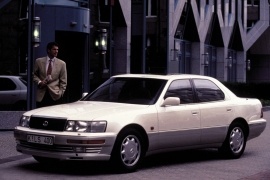
Hailed as the flagship of Lexus in its luxury sedan market, the LS has had quite the history.
When this first generation was introduced in 1990 it was among the first cars to have digital A/C readouts, power adjustable shoulder belts, heated front seats and auto-off headlamps. Some came equipped with air suspension and a premium sound system. No wonder this first generation was a success selling between 21,000 and 42,000 units annually. Another reason for its success was the fact that it was seriously underpriced when compared to similar vehicles on the market at the time.























































